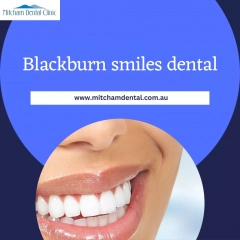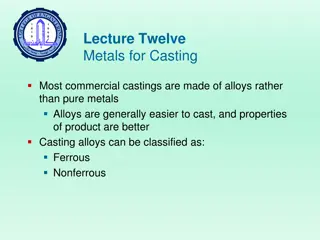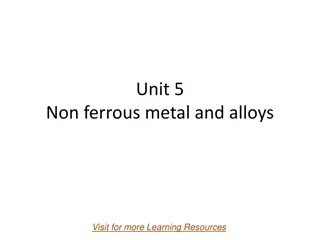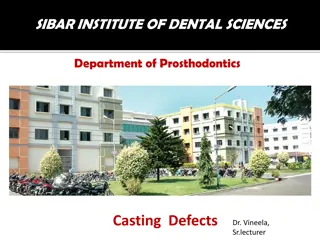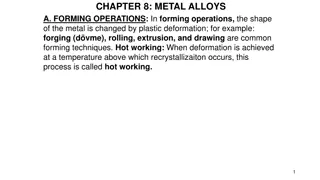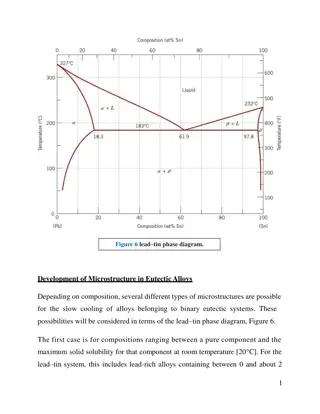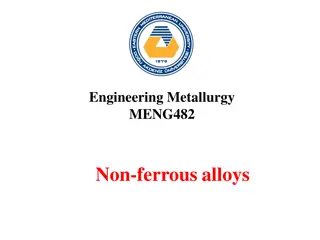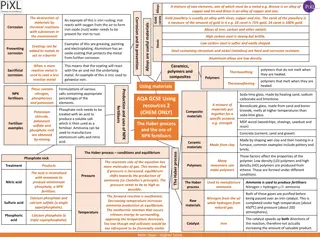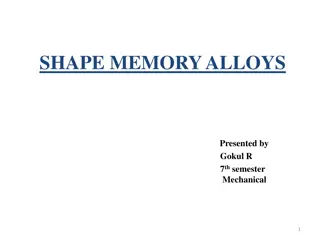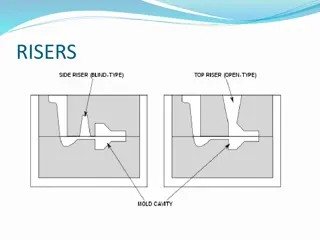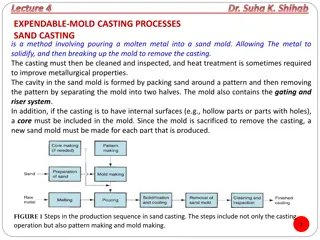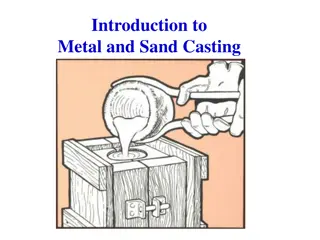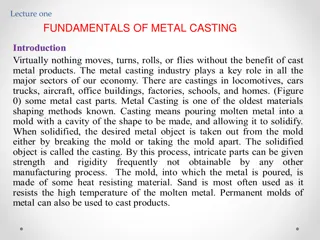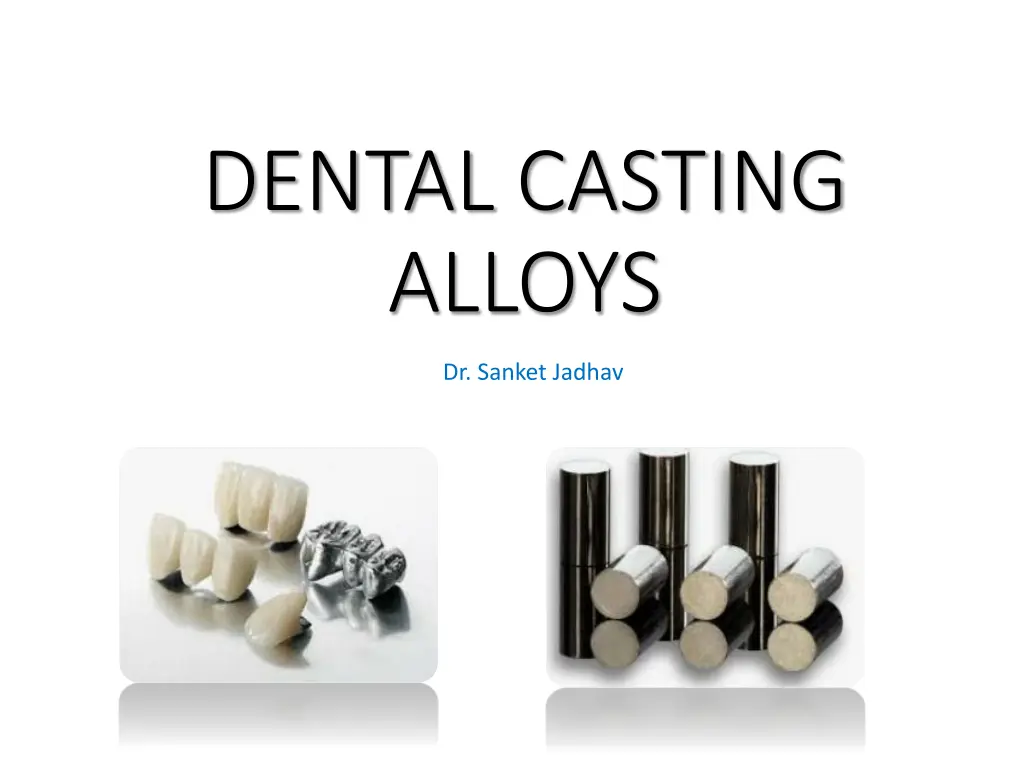
Understanding Dental Casting Alloys
Explore the world of dental casting alloys with a focus on metals, alloys, terminologies, and the classification of dental casting alloys. Learn about noble and base metals, as well as precious metals like gold, silver, palladium, and platinum commonly used in dentistry. Discover the process of casting and the essential role of alloys in creating dental restorations and prostheses.
Download Presentation

Please find below an Image/Link to download the presentation.
The content on the website is provided AS IS for your information and personal use only. It may not be sold, licensed, or shared on other websites without obtaining consent from the author. If you encounter any issues during the download, it is possible that the publisher has removed the file from their server.
You are allowed to download the files provided on this website for personal or commercial use, subject to the condition that they are used lawfully. All files are the property of their respective owners.
The content on the website is provided AS IS for your information and personal use only. It may not be sold, licensed, or shared on other websites without obtaining consent from the author.
E N D
Presentation Transcript
DENTAL CASTING ALLOYS Dr. Sanket Jadhav
Metal restorations and prostheses are an integral part of dentistry. Metals and its alloys are among the strongest materials and provide strength and durability to any structure.
Casting A process in which a material such as metal or plastic in liquid form/molten state is poured into a mold and allowed to become hard upon cooling, in order to make parts or products. Alloy A homogenous mixture of two or more metals, or a metal and a non-metal is called an alloy. Example- Brass : Copper and Zinc Carbon Steel : Iron and Carbon Stainless Steel- Iron, Carbon and Chromium
Terminologies NOBLE METALS- Resistance to corrosion. Used for inlays, crowns and FDPs. Gold, platinum, palladium, rhodium, ruthenium, iridium, osmium, and Silver PRECIOUS METALS- The term precious indicates the intrinsic value of the metal. The eight noble metals are also precious metals and are defined so by major metallurgical societies and federal government agencies, e.g. National Institute of Standards and Technology and National Material Advisory Board.
Gold Pure gold is a soft and ductile metal with a yellow gold hue. It has a density of 19.3 g/cm3 and a melting point of 1063 C. Gold has a good luster and takes up a high polish. It has good chemical stability and does not tarnish and corrode under normal circumstances. Silver Sometimes described as the whitest of all metals. It has the lowest density (10.4 g/ cm3 ) and melting point (961 C) among the precious casting alloys. Its CTE is 15.7 10-6/ C which is comparatively high. ( In large amounts, it increases tarnish) Palladium Density is 12.02 g/cm3 . Palladium has a higher melting point (1552 C). It hardens and whitens the alloy. Platinum It has the highest density (21.65 g/cm3 ) highest melting point (1769 C) and the lowest CTE among the four precious metals. Increases strength and corrosion resistance.
BASE METALS- (also called as ,Non noble, Non-Precious) Metals which contain no precious elements like gold, silver, platinum or palladium. But are, important component of dental casting alloys because of their influence on physical properties, control of the amount and their type of oxidation & their strengthening effect. eg. Chromium, cobalt, nickel, copper, Iron, etc
CLASSIFICATION OF DENTAL CASTING ALLOYS According to use a. Alloys for all metal and resin veneer restorations eg. Inlays,posts,resins(acrylic) and composite veneered crowns b. Alloys for metal ceramic restorations eg. PFM crowns & FDPs c. Alloys for removable dentures
Based on yield strength and percent elongation a. Type I Soft b. Type II Medium c. Type III Hard d. Type IV Extra Hard This 1934 classification was originally intended for gold alloys and were based on hardness. Types I and II are known as inlay alloys and Types III and IV are known as crown and bridge alloys . Type IV is occasionally used for RPD frames)
According to Nobility High noble alloys have a noble metal (gold, platinum, palladium,ETC ) content greater than 60%, with at least 40% gold. Noble alloys have a noble metal content of at least 25%, and Predominantly base alloys have less than 25% noble metal content. Base metal Chromium,cobalt,nickel,copper,Iron, etc
Based on mechanical properties a. Type 0 Intended for low stress bearing single tooth fixed restorations eg. Small veneered one-surface inlays , veneered crowns b. Type 1 Intended for low stress bearing single tooth fixed restorations eg. Veneered or unveneered one-surface inlays, veneered crowns c. Type 2 Intended for single tooth fixed restorarions eg. Crowns or inlays without restorations on no. of surfaces d. Type 3 Intended for multiple unit fixed restoration eg, bridges e. Type 4 Intended for appliances with thin sections that are subject to very high forced eg. Removable partial dentures, clasps, wide span bridges implant retained superstructures. f. Type 5 Intended for appliances in which parts require the combination of high stiffness and strength eg. Thin removable partial dentures
According to major elements a. Gold alloys b. Silver alloys c. Palladium alloys d. Nickel alloys e. Cobalt alloys f. Titanium alloys
According to three major elements a. Gold-palladium-silver b. Palladium-silver-tin c. Nickel-chromium-molybdenum d. Cobalt-chromium-molybdenum e. Iron-nickel-chromium f. Titanium-aluminium-vanadium
According to the number of alloys present a. Binary- two elements b. Tertiary- three elements c. Quaternary- four elements
CLASSIFICATION ACCORDING TO USE OF DENTAL CASTING ALLOYS 1. - Noble - Predominantly base metal - Base metal 2. Alloys for metal-ceramics restorations - High noble - Noble - Predominantly base material - Base metal 3. Alloys for casting large structures - High noble - Noble - Predominantly base material - Base material Alloys for all metal and resin veneer restorations: - High noble
GENERAL REQUIREMENTS OF CASTING ALLOYS GENERAL REQUIREMENTS OF CASTING ALLOYS All cast metals in dentistry have basic common requirements 1. They must not tarnish and corrode in mouth 2. They must be sufficiently strong for intended purpose 3. They must be biocompatible 4. They must be easy to melt, cast, cut & grind 5. They must flow well and duplicate fine details during casting 6. They must have minimal shrinkage on cooling and casting 7. They must be easy to solder
According to use a. Alloys for all metal and resin veneer restorations eg. Inlays,posts,resins(acrylic) and composite veneered crowns b. Alloys for metal-ceramic restorations eg. PFM crowns & FDPs c. Alloys for removable dentures
a. Alloys for all metal and resin veneer restorations These alloys were among the earliest alloys available to dentistry. The early alloys were mostly gold alloys. Since they were intended for all-metallic and later for resin/acrylic veneered restorations, they just had to meet the basic requirements. Currently, the use of these alloys are slowly declining because of Increased esthetic awareness has reduced the trend for metal display. Increasing popularity of all-ceramic and metal-ceramic restorations. Reducing popularity of resin and composite as veneering material.
a. Alloys for all metal and resin veneer restorations Resin/acrylic facings have a number of disadvantages. They wear rapidly (poor wear resistance). They may change color (color instability and stain absorption). They are porous. They tend to absorb food material and bacteria. This makes it unhygienic and gives it a bad odor
a. Alloys for all metal and resin veneer restorations USES: Inlays and onlays Crowns and FDPs Partial denture frames Post-cores
a. Alloys for all metal and resin veneer restorations High noble Gold alloys Noble Silver palladium alloys Base metal Nickel-chrome alloys Cobalt-chrome alloys Titanium and its alloys Aluminum-bronze alloys
b. Alloys for metal-ceramic restorations eg. PFM crowns & FDPs Metal-ceramic alloys are those alloys that are compatible with porcelain and capable of bonding to it. A layer of porcelain is fused to the alloy to give it a natural tooth-like appearance. Porcelain being a brittle material fractures easily, so these alloys are used to reinforce the porcelain. Several types of alloys are used to cast substructures for porcelain- fused-to-metal crowns and FDPs. They may be noble metal alloys or base metal alloys. All have coefficient of thermal expansion (CTE) values which match that of porcelain.
c. Alloys for removable dentures Larger structures like complete denture bases and partial denture frames are also made from dental alloys. Being larger structures they require more quantities of alloy, which can make them quite heavy and expensive (if gold were to be used). Thus it became necessary to develop lighter and more economical alloys.
c. Alloys for removable dentures The alloys for removable denture use are 1. Cobalt-chromium alloys 2. Nickel-chromium alloys 3. Aluminum and its alloys 4. Type IV noble alloys 5. Titanium
SUMMARY WHAT IS AN ALLOY? METALS, PRECIOUS METALS, BASE METALS CLASSIFICATION OF DENTAL CASTING ALLOYS IDEAL REQUIREMENTS OF DENTAL CASTING ALLOYS CASTING ALLOYS IN PROSTHODONTICS

